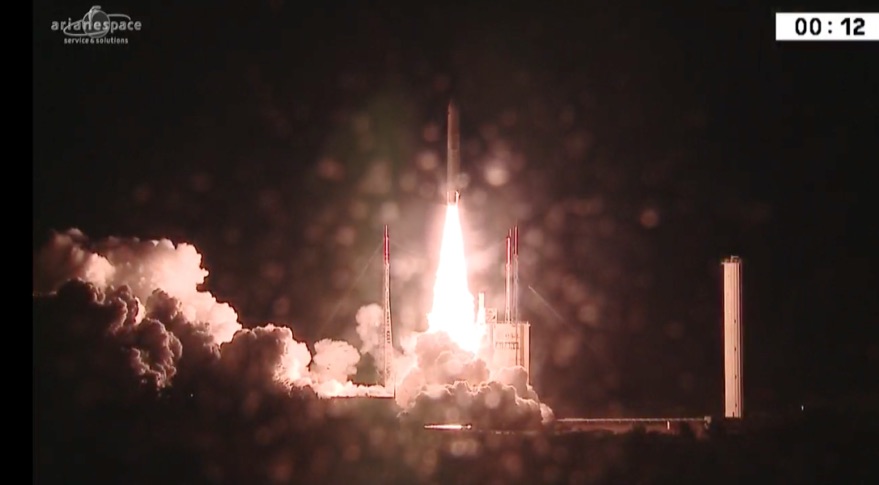Arianespace Rocket Launches Two Heavy Satellites to Get Back on Schedule

MT LAUREL, New Jersey — European launch provider Arianespace's successful launch of ViaSat and Eutelsat telecommunications satellites June 1 on an Ariane 5 rocket marked the completion of all missions offset by protests in French Guiana during March and April.
Arianespace launched both satellites at 7:45 p.m. EDT from Kourou, French Guiana, releasing the 6,400-kilogram ViaSat-2 satellite 29 minutes after liftoff, followed by the 3,550-kilogram Eutelsat-172b satellite 12 minutes later.
Territory-wide protests in French Guiana highlighting societal concerns including safety, healthcare and standards of living, used a blockade of the Guiana Space Centre, Europe's spaceport, as a both a bartering chip and a means to gain France's attention. Those protests halted launch activity for Arianespace for five weeks, delaying two Ariane 5 missions and one Soyuz launch until France and its South American territory reached an accord that promised increased resources devoted to French Guiana.
Arianespace repurposed time previously allocated for spaceport maintenance to catching up on the three delayed missions. The launch provider remains on track for 12 missions this year — seven Ariane 5, three Vega and two Soyuz.
Arianespace's June 1 launch marked the heaviest mission the Ariane 5 has completed to date, and 79th mission overall. At 10,865-kilograms total, including satellites and rocket hardware, Arianespace CEO Stéphane Israel said in a June 1 statement that the company's improved knowledge of the Ariane 5's capabilities enabled the company to increase its maximum launch weight by 1.5 metric tons since its inception. Before the rocket is phased out for the next generation Ariane 6, Israel said Arianespace intends to further increase its capability by another 250 kilograms between now and 2019.
Speaking at a post-launch press conference, Mark Spiwak, president of Boeing Satellite Systems International, said ViaSat-2 is the largest satellite Boeing has built to date. The satellite carries more than twice the throughput of the 140-Gbps ViaSat-1 satellite, and has seven times the coverage. ViaSat-2 provides breathing room for ViaSat's residential broadband subscriber business, which has prioritized higher paying customers as a means to fend off revenue loss from subscriber churn on the largely occupied ViaSat-1. The new satellite covers North America, the upper part of South America, and parts of the ocean around the continent, including the North Atlantic, with a footprint that bridges to connect with Eutelsat's Ka-Sat for transatlantic flights.
ViaSat-2 was originally scheduled to launch on a SpaceX Falcon Heavy in 2016, but ViaSat reassigned the launch to Arianespace in light of delays with the Falcon Heavy's development.
Get the Space.com Newsletter
Breaking space news, the latest updates on rocket launches, skywatching events and more!
Eutelsat-172b, with coverage of the Asia-Pacific, also has capacity for in-flight connectivity. Panasonic Avionics will use 11 elliptical Ku-band beams to cover flight paths between the North American West coast, Asia and Australia. The satellite carries C- and Ku-band capacity, replacing Eutelsat-172a, which Eutelsat intends to relocate.
Built by Airbus Defence and Space, Eutelsat-172b is an all-electric propulsion satellite that uses robotic arms to hold thrusters that will raise the spacecraft to geostationary orbit. Eutelsat expects the satellite to enter service by year's end.
Eutelsat and ViaSat closed a broadband-focused joint venture in March with a wholesale services division focused on internet for mobile platforms and wholesale broadband, and a retail services division. Both focus on serving Europe and the Mediterranean. The joint venture includes an investment by ViaSat into Eutelsat's Ka-Sat and an investment by Eutelsat in the second of ViaSat's three ViaSat-3 satellites, which is slated to cover Europe, the Middle East and Africa.
In a May 25 filing with the U.S. Securities and Exchange Commission, ViaSat said it expects to launch the first two ViaSat-3 satellites "in approximately three to four years," placing the missions in the 2020 to 2021 timeframe. ViaSat previously expected to launch the satellites in 2019 and either late 2019 or 2020.
This story was provided by SpaceNews, dedicated to covering all aspects of the space industry.
Join our Space Forums to keep talking space on the latest missions, night sky and more! And if you have a news tip, correction or comment, let us know at: community@space.com.
Caleb Henry is a senior analyst for Quilty Analytics and a former staff writer for the space industry publication SpaceNews. From 2016 to 2020, Caleb covered the global satellite industry for SpaceNews, chronicling everything from launches, spacecraft manufacturing and ground infrastructure. Caleb's work has also appeared in NewSpace Global and Access Intelligence. He earned a bachelor's degree in political science with a minor in astronomy from Grove City College.










